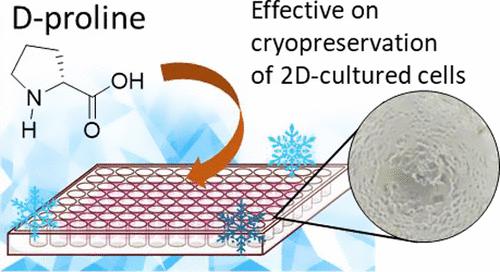当前位置:
X-MOL 学术
›
ACS Biomater. Sci. Eng.
›
论文详情
Our official English website, www.x-mol.net, welcomes your feedback! (Note: you will need to create a separate account there.)
Microplate-Based Cryopreservation of Adherent-Cultured Human Cell Lines Using Amino Acids and Proteins
ACS Biomaterials Science & Engineering ( IF 5.8 ) Pub Date : 2024-03-26 , DOI: 10.1021/acsbiomaterials.3c01834 Kenta Morita 1, 2 , Tomoko Yashiro 1 , Takashi Aoi 3 , Ryutaro Imamura 4 , Tomoyuki Ohtake 4 , Norihiro Yoshizaki 4 , Tatsuo Maruyama 1, 2
ACS Biomaterials Science & Engineering ( IF 5.8 ) Pub Date : 2024-03-26 , DOI: 10.1021/acsbiomaterials.3c01834 Kenta Morita 1, 2 , Tomoko Yashiro 1 , Takashi Aoi 3 , Ryutaro Imamura 4 , Tomoyuki Ohtake 4 , Norihiro Yoshizaki 4 , Tatsuo Maruyama 1, 2
Affiliation

|
With the progression of regenerative medicine and cell therapy, the importance of cryopreservation techniques for cultured cells continues to rise. Traditional cryoprotectants, such as dimethyl sulfoxide and glycerol, are effective in cryopreserving suspended cells, but they do not demonstrate sufficient efficacy for two-dimensional (2D)-cultured cells. In the past decade, small molecules and polymers have been studied as cryoprotectants. Some L-amino acids have been reported to be natural and biocompatible cryoprotectants. However, the cryoprotective effects of D-amino acids have not been investigated for such organized cells. In the present study, the cryoprotective effects of D- and L-amino acids and previously reported cryoprotectants were assessed using HepG2 cells cultured on a microplate without suspending the cells. d-Proline had the highest cryoprotective effect on 2D-cultured cells. The composition of the cell-freezing solution and freezing conditions were then optimized. The d-proline-containing cell-freezing solution also effectively worked for other cell lines. To minimize the amount of animal-derived components, fetal bovine serum in the cell freezing solution was substituted with bovine serum albumin and StemFit (a commercial supplement for stem cell induction). Further investigations on the mechanism of cryopreservation suggested that d-proline protected enzymes essential for cell survival from freeze-induced damage. In conclusion, an effective and xeno-free cell-freezing solution was produced using d-proline combined with dimethyl sulfoxide and StemFit for 2D-cultured cells.
中文翻译:

使用氨基酸和蛋白质对贴壁培养的人类细胞系进行基于微孔板的冷冻保存
随着再生医学和细胞治疗的进步,培养细胞冷冻保存技术的重要性不断上升。传统的冷冻保护剂,例如二甲亚砜和甘油,可有效冷冻保存悬浮细胞,但它们对于二维 (2D) 培养的细胞没有表现出足够的功效。在过去的十年中,小分子和聚合物已被研究作为冷冻保护剂。据报道,一些L-氨基酸是天然且生物相容的冷冻保护剂。然而, D-氨基酸对此类组织细胞的冷冻保护作用尚未得到研究。在本研究中,使用在微孔板上培养的 HepG2 细胞而不悬浮细胞来评估D-和L-氨基酸以及先前报道的冷冻保护剂的冷冻保护作用。 d-脯氨酸对二维培养细胞具有最高的冷冻保护作用。然后优化细胞冷冻溶液的组成和冷冻条件。含有d-脯氨酸的细胞冷冻溶液对于其他细胞系也有效。为了最大限度地减少动物源性成分的含量,细胞冷冻溶液中的胎牛血清被牛血清白蛋白和 StemFit(一种用于干细胞诱导的商业补充剂)替代。对冷冻保存机制的进一步研究表明,d-脯氨酸可以保护细胞生存所必需的酶免受冷冻诱导的损伤。总之,使用d-脯氨酸与二甲基亚砜和 StemFit 组合,为 2D 培养细胞生产了一种有效且无异源的细胞冷冻溶液。
更新日期:2024-03-26
中文翻译:

使用氨基酸和蛋白质对贴壁培养的人类细胞系进行基于微孔板的冷冻保存
随着再生医学和细胞治疗的进步,培养细胞冷冻保存技术的重要性不断上升。传统的冷冻保护剂,例如二甲亚砜和甘油,可有效冷冻保存悬浮细胞,但它们对于二维 (2D) 培养的细胞没有表现出足够的功效。在过去的十年中,小分子和聚合物已被研究作为冷冻保护剂。据报道,一些L-氨基酸是天然且生物相容的冷冻保护剂。然而, D-氨基酸对此类组织细胞的冷冻保护作用尚未得到研究。在本研究中,使用在微孔板上培养的 HepG2 细胞而不悬浮细胞来评估D-和L-氨基酸以及先前报道的冷冻保护剂的冷冻保护作用。 d-脯氨酸对二维培养细胞具有最高的冷冻保护作用。然后优化细胞冷冻溶液的组成和冷冻条件。含有d-脯氨酸的细胞冷冻溶液对于其他细胞系也有效。为了最大限度地减少动物源性成分的含量,细胞冷冻溶液中的胎牛血清被牛血清白蛋白和 StemFit(一种用于干细胞诱导的商业补充剂)替代。对冷冻保存机制的进一步研究表明,d-脯氨酸可以保护细胞生存所必需的酶免受冷冻诱导的损伤。总之,使用d-脯氨酸与二甲基亚砜和 StemFit 组合,为 2D 培养细胞生产了一种有效且无异源的细胞冷冻溶液。



























 京公网安备 11010802027423号
京公网安备 11010802027423号